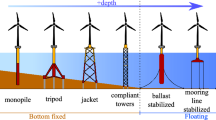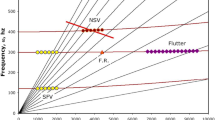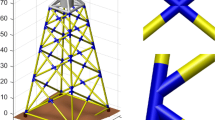Abstract
The purpose of the research presented in this paper is to develop and implement an efficient method for analytical gradient-based sizing optimization of a support structure for offshore wind turbines. In the jacket structure optimization of frame member diameter and thickness, both fatigue limit state, ultimate limit state, and frequency constraints are included. The established framework is demonstrated on the OC4 reference jacket with the NREL 5 MW reference wind turbine installed at a deep water site. The jacket is modeled using 3D Timoshenko beam elements. The aero-servo-elastic loads are determined using the multibody software HAWC2, and the wave loads are determined using the Morison equation. Analytical sensitivities are found using both the direct differentiation method and the adjoint method. An effective formulation of the fatigue gradients makes the amount of adjoint problems that needs to be solved independent of the amount of load cycles included in the analysis. Thus, a large amount of time-history loads can be applied in the fatigue analysis, resulting in a good representation of the accumulated fatigue damage. A reduction of 40 % mass is achieved in 23 iterations using the CPLEX optimizer by IBM ILOG, where both fatigue and ultimate limit state constraints are active at the optimum.







Similar content being viewed by others
References
Akgün MA, Haftka RT, Wu KC, Walsh JL, Garcelon JH (2001) Efficient Structural Optimization for Multiple Load Cases Using Adjoint Sensitivities. AIAA Journal (3):511–516
Chew KH, Tai K, Ng EYK, Muskulus M (2015) Optimization of offshore wind turbine support structures using an analytical gradient-based method. Energy Procedia 80:100–107
Chin CM, Fletcher R (2003) On the global convergence of an SLP-filter algorithm that takes EQP steps. Math Program 96(1):161–177
Cook RD, Malkus DS, Plesha ME, Witt RJ (2002) Concepts and applications of finite element analysis, 4th edn. John Wiley & Sons, New York
Courant R, Hilbert D (1953) Methods of mathematical physics, vol 1. Interscience Publishers, New York
DNV (2011) DNV-OS-C101: Design of offshore steel structure General (LRFD method). Det Norske Veritas, Høvik
DNV (2014) RP-C203: Fatigue design of offshore steel structures. Det Norske Veritas, Høvik
DTU Wind Energy (2016). HAWC2. http://www.hawc2.dk
EN (2005a) Eurocode 3: Design of steel structures - Part 1-1: General rules and rules for buildings. European Committee for Standardization, Brussels
EN (2005b) Eurocode 3: Design of steel structures - Part 1-8: Design of joints. European Committee for Standardization, Brussels
Fischer T, De Vries W, Schmidt B (2010) UpWind Design Basis. Tech. rep
Fletcher R, Leyffer S, Toint P (1998) On the global convergence of an SLP-filter algorithm. Tech. rep., Numerical Analysis Report NA/183 Department of Mathematics, University of Dundee, Scotland
Gere J, Goodno B (2012) Mechanics of Materials. Cengage Learning
Hasselmann K, Barnett TP, Bouws E, Carlson H, Cartwright DE, Enke K, Ewing JA, Gienapp H, Hasselmann DE, Kruseman P, Meerburg A, Müller P, Olbers DJ, Richter K, Sell W, Walden H (1973) Measurements of Wind-Wave growth and swell decay during the joint north sea wave project (JONSWAP). Tech Rep Ergaenzungsheft zur Deutschen Hydrographischen Zeitschrift, Reihe A (8), 12
IEC (2005) IEC 61400-1 Wind Turbines - Part 1: Design requirements, vol 2005. International Electrotechnical Commission, Geneva
IEC (2009) IEC 61400-3 Wind Turbines - Part 3: Design Requirements for offshore wind turbines. International Electrotechnical Commission, Geneva
Jonkman J, Butterfield S, Musial W, Scott G (2009) Definition of a 5-MW reference wind turbine for offshore system development. Tech. Rep. February
Jonkman J, Robertson A, Popko W, Vorpahl F, Zuga A, Kohlmeier M, Larsen TJ, Yde A, Saetertro K, Okstad KM, Nichols J, Ta Nygaard, Gao Z, Manolas D, Kim K, Yu Q, Shi W, Park H, Vasquez-Rojas A, Dubois J, Kaufer D, Thomassen P, de Ruiter MJ, Peeringa J, Zhiwen H, von Waaden H (2012) Offshore code comparison collaboration continuation (OC4), phase I - Results of coupled simulations of an offshore wind turbine with jacket support structure. Isope 2012 1(March):1–11
Kühn M (2001) Dynamics and design optimisation of offshore wind energy conversion systems. PhD thesis, TU Delft
Long H, Moe G (2012) Preliminary design of bottom-fixed lattice offshore wind turbine towers in the fatigue limit state by the frequency domain method. J Offshore Mech Arct Eng 134(3):31,902
Long H, Moe G, Fischer T (2011) Lattice towers for bottom-fixed offshore wind turbines in the ultimate limit state: variation of some geometric parameters. J Offshore Mech Arct Eng 134(2):21,202
Morison JR, O’Brien MP, Johnson J, Schaaf S (1950) The force exerted by surface waves on piles. Petroleum Transactions 189
Muskulus M, Schafhirt S (2014) Design optimization of wind turbine support structures - a review. J Ocean Wind Energy 1(1):12–22
Seyranian AP, Lund E, Olhoff N (1994) Multiple eigenvalues in structural optimization problems. Struct Optim 8(4):207–227
Sørensen SN, Sørensen R, Lund E (2014) DMTO a method for Discrete Material and Thickness Optimization of laminated composite structures. Struct Multidiscip Optim 50(1):25–47
Thiry A, Bair L, Buldgen GR, Rigo P (2011) Optimization of monopile offshore wind structures. Adv Mar Struct, Taylor & Francis, pp 633–642
Tortorelli D, Michaleris P (1994) Design sensitivity analysis: Overview and review. Inverse Prob Sci Eng 1 (1):71–105
Uys PE, Farkas J, Jármai K, van Tonder F (2007) Optimisation of a steel tower for a wind turbine structure. Eng Struct 29(7):1337–1342
Vorpahl F, Kaufer D, Popko W (2011) Description of a basic model of the ”Upwind reference jacket” for code camparison in the OC4 project under IEA Wind Annex 30. Tech. rep., Institute for Wind Energy and Energy Systems Technology
Wittrick WH (1962) Rates of change of eigenvalues with reference to buckling and vibration problems. J R Aeronaut Soc 66:590–591
Zwick D, Muskulus M (2015) Simplified fatigue load assessment in offshore wind turbine structural analysis. Wind Energy 19(2):265–278
Zwick D, Muskulus M, Moe G (2012) Iterative optimization approach for the design of full-height lattice towers for offshore wind turbines. Energy Procedia 24:297–304
Acknowledgments
This research is part of the project ABYSS - Advancing BeYond Shallow waterS - Optimal design of offshore wind turbine support structures sponsored by the Danish Council for Strategic Research, Grant no. 1305-00020B. This support is gratefully acknowledged. The authors would also like to thank all partners within the project.
Author information
Authors and Affiliations
Corresponding author
Rights and permissions
About this article
Cite this article
Oest, J., Sørensen, R., T. Overgaard, L.C. et al. Structural optimization with fatigue and ultimate limit constraints of jacket structures for large offshore wind turbines. Struct Multidisc Optim 55, 779–793 (2017). https://doi.org/10.1007/s00158-016-1527-x
Received:
Accepted:
Published:
Issue Date:
DOI: https://doi.org/10.1007/s00158-016-1527-x




